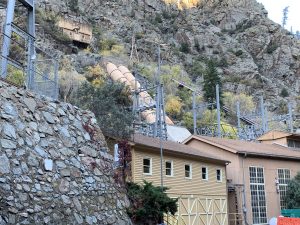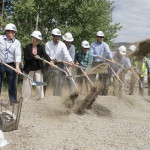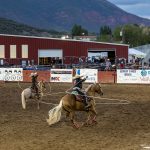blog: How safe is whitewater rafting?
Vail CO, Colorado

Five people have lost their lives on the Arkansas River this season on commercial raft trips (one was a guide trainee on a training trip). This has caused a huge amount of discussion, speculation, fear and arguing about whether or not whitewater rafting, especially commercially guided raft trips, is a safe activity for people to participate in.
What is “safe”?
One of the great debates recently in the whitewater community is how can we make guests better informed about the risks involved to allow them to make better decisions for themselves?
The reason for so much debate and squabbling revolves around the fact that no one can agree on what makes an activity “safe” or “unsafe”. The truth is, one person’s idea of “safe” may be totally different from someone else.

Support Local Journalism
For some people, safety is an emotional response to fear or discomfort. Others base their feeling of being “safe” or “unsafe” on rational, informed decisions using facts. For some people, “safety” is a combination of the two.
Relatively Speaking
For me, I like to think of how safe something is compared to other activities. In my mind, everything is relative. American Whitewater knows more about river safety and accidents than any other organization in the world.
They catalog river and whitewater boating accidents, investigate them, and have been documenting them for years in an effort to improve safety. Using their data, if I told you that whitewater boating has a .86/100,000 fatality/user day ratio, it wouldn’t really mean a whole lot.
Only when you look at it in context of other sports does it really mean anything. For example, I participate in skiing, and occasionally cycling. The fatality rates for these activities are .4 and 1.6, respectively. This puts whitewater boating roughly in between these two sports.
For me, this is a relatively acceptable risk to take. I may consider a different sport if whitewater boating were 100 or 1000 times more likely to result in my death than skiing, but this simply is not the case.
While it is difficult to compare the statistics, every study I have seen points to driving an automobile as being more dangerous than whitewater boating with a fatality rate of 15.2. (for further reading, visit http://www.americanwhitewater.org/content/Article_view_articleid_1614_display_full_)
Overall, if you look at things rationally, whitewater rafting is a pretty “safe” activity to participate in. Hundreds of thousands of people safely enjoy guided raft trips each year in Colorado. Also, each season untold thousands of people swim whitewater, capsize boats, and get thrown overboard and live to tell about it.
Emotionally Speaking
Rafting is an adventure sport, and like other adventure sports, the element of danger is part of the thrill that makes people want to participate. The fact is, tumbling down whitewater rapids outside of a boat can be quite dangerous in some instances.
More commonly, however, “swimming” whitewater is usually just an intense and memorable experience that leaves the uninitiated disoriented, wet and cold. Imagine riding a roller coaster while inside a washing machine on full spin cycle. The danger of drowning, injury, or hypothermia is very real, and to the “swimmer” can become a panicky certainty even if no real danger is present.
Accidents do happen, however, there is no denying it. The families of those who were lost in these accidents can attest to this. When tragedies take place, they happen to real people, with families, careers, ambitions and dreams. Despite all of the statistics, a single death on the river is one too many.
As mentioned before, safety is in the eye of the beholder, and fear and ignorance can make one man’s adventure another’s hellish out-of-control nightmare. The emotional factor has already reared its head in the media and even with some people I have talked to on the river.
One man I spoke with looked at me like I was crazy when I mentioned I was on the Arkansas River the week before.
“No way I’m going on the Arkansas, with all those deaths over there!” was their response. The attitudes surrounding commercial rafting run the gamut. Many commercial raft guests consider the river a glorified amusement park ride. Guests have no reference for the power of fast moving water, having never been swept away themselves. Some are so clueless about the experience that they show up wearing the same dressy clothes they would wear to a nice dinner at the Ritz.
At the other end of the spectrum are the irrational people who consider rafting a death-wish. Many of them have seen sensational accounts of river accidents, and assume this must be an everyday occurrence.
Others have taken a spill or a swim, became frightened, and assumed their panic must mean they have experienced a life threatening swim.
A perfect example of the uninformed in the media comes from Dr. Clay J. Cockerell in the Vail Daily. Cockerell’s letter to the editor explains his account of a “near rafting disaster” that occurred on the Shoshone section of the Colorado. Cockerell explains that in choosing the section of river to run, they opted not to take a trip on the Arkansas River for safety reasons. He heard about accidents on the Arkansas, and jumped to the conclusion that it must be an unsafe river.
In his letter, he accepts that rationally speaking, rafting is safe, then goes on to describe how several members of his family fell out of the boat on a raft trip. From his story, I piece together that four people fell out of the raft when it struck a rock. The swimmers collected in the calm water below the rapid and brought back on board.
Cockerell makes a whole lot of assumptions and emotional statements like “close to drowning”, “nearly went through a dangerous rapid with rocks and whitewater”, “could have been severely injured or drowned”. He comes to the conclusion that there should be stricter criteria for the number of individuals on each raft, and that guides need to be screened better.
He offers all kinds of expert analysis on the situation and speculates that had the raft capsized multiple people would have been killed.
(See https://www.vaildaily.com/article/20070803/LETTER/70802046)
While I do not deny that this was probably a scary experience for Dr. Cockerell and his family, this is a great example of irresponsible statements in the media regarding the safety of rafting. While I have no question of Dr. Cockerell’s qulifications in the medical field, I must say that he is not qualified to speculate and assume that a capsized raft on Shoshone would lead to certain death.
In fact, I can personally attest, having swam every single rapid in that section, that it is possible to survive a capsize in this section of whitewater, and I’m not that great of a swimmer.
The fact of the matter is, Dr. Cockerell and his family probably shouldn’t have been rafting, even though they came to find out they did, in fact, have the ability to self-rescue in a frightening situation. If you ever go rafting, you are automatically accepting the fact that you may swim, or the boat may capsize, and you may have to actively help yourself to another boat, or out of the river.
Picking the Right Trip
The problem with rafting, is that guides and raft companies are not qualified to make decisions about how you will react with an unexpected swim. While there are obvious reasons a guide may choose to not allow you on a trip (oxygen tank and a pacemaker anyone?) there are many more factors your guide can’t be aware of.
The guide and the raft company reservationists can only compare you to other guests. Families with five-year-olds daily enjoy the Shoshone rapids, and have the times of their lives.
Rarely, other families may find the first 20 minutes of rapids totally outside of their limited comfort zone. If you are choosing a raft trip, it is best if you keep in mind your own situation and limitations. Every so often, guides turn away a handful of people who become nervous and frightened after our safety talk.
Every year a few people get geared up, and decide that they are not comfortable going on the trip. Outfitters will never try to talk someone into doing something they don’t want to do, but I can assure you that usually my most satisfied guests are those who were a little anxious, and came out with a huge smile and a sense of accomplishment.
The best way for you to determine if a trip is good for you or not, is to try out some easier trips, and work your way up to more difficult trips. This is probably the most important reason outfitters require experience on more difficult trips.
Paddling experience is not as important as the customers knowing what they are getting themselves into. Most trips advertised as a “family” trip, like Shoshone, are appropriate for all except those who are extremely apprehensive around the water. If this is the case, I would recommend a gentle float trip like the Upper Colorado. You also always have the option of sitting out the first 20 minutes of rapids on Shoshone and joining the group at the next stop for a very gentle section of river.
I would also recommend that when you go on a raft trip you consider the following.
1. If I fall out of the raft, there is a minute possibility that I might go for a nasty swim where the guide can’t help me. If this happens, I might have to save myself.
2. If I don’t know whether or not I could save myself, I am at least comfortable that I understand and accept the small amount of risk involved and it is worth for me to have an adventurous experience.
Most of us in the whitewater community agree that one of the things that we could do better is keeping our guests informed about risk, and rescue. Some people think we should advertise that rafting is super dangerous and only for ultra-fit daredevils. The problem with that is that is just flat isn’t true.
Rafting can be a fun and appropriate activity for most regular folks who come to the Valley seeking a little adventure. The best advice I can give you is to ask questions about the trip you want to go on, and make informed decisions. If you have questions about a specific section of river, ask the outfitter to speak to someone in advance who guides that section of river.
Will I fall in?
Swimming is to rafting what falling is to skiing. It is a part of the sport. Most people who swim whitewater leave with a thrilling experience that leaves them wet, and a little shaken. On trips advertised as “family” trips, such as Shoshone, involuntary swims are pretty rare.
For example, last season I guided full time on those “family” sections, and never once had a guest swimmer on a commercial trip. Most of the time we have swimmers, they are right next to the boat, and are quickly pulled back in. The risk of falling in gets higher with the difficulty of river (outfitters raft from class I to V). On a class V trip, there is a very good chance you could swim, and if you do, it will be intense. On a class III trip, there usually aren’t swimmers, and if they are, the risk of injury is very low.
Will the guide save me?
While some people are questioning guide’s qualifications, there is actually a state licensing process that requires rigorous training to become a guide. Most local guides greatly exceed this minimum requirement by having extra training and experience.
Many guides are certified swiftwater rescue technicians. In fact, if you call 911 when there is a river disaster and help is needed, many of the rescuers are the local guides. Lots of guides are also EMTs or ski patrollers who have lots of medical training.
Each trip has a leader who has a minimum of 500 miles of whitewater guiding under his or her belt, and usually much more. The truth is, most guides are professionals, and are very good at what they do”provide safe, fun adventures for their guests.
Some people would argue that the quality of guides you will get can vary by company, and I tend to agree with this. The locally based rafting companies, Lakota, Nova, and Timberline, however, all do an excellent job of maintaining a staff of highly qualified professionals guiding on our local rivers. In fact, despite the recent tragedy involving Nova, I wouldn’t hesitate for a second to send any member of my family on a river trip with them or one of the other companies.
While guides are very good at what they do, they are still limited by the rules of nature and physics. Mike Mather, a guide at Lakota and one of the top river rescue experts in the world, said it best: “I can help extract you from the river, but I can’t make the water any slower or warmer, or the rocks any softer or less pointy.” The same is true of your guide.
While most of the time, their training allows them to react successfully to lots of situations, when it comes down to it, if your guide isn’t in a position to help, you have to help yourself.
See You On The River
I hope that by having some more information from a river person who is also a guide (once again, not the best, most experienced, or handsomest) will help you to be a slightly more informed participant in whitewater rafting. Pay attention to your guide’s orientation talks, ask questions, and if you aren’t comfortable with something don’t hesitate to speak up. It is a voluntary activity, after all. Oh, and once you hit the water, have some fun out there! S.Y.O.T.R
David Dempsey can be reached at ddempsey@managed-data.com.










